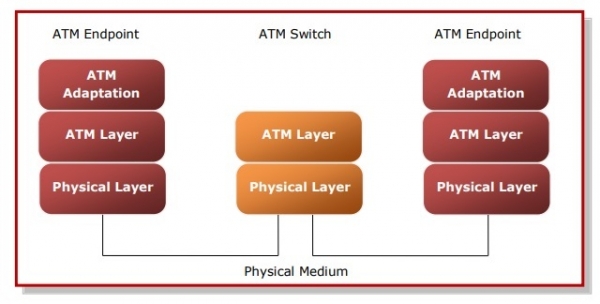
 Data Structure
Data Structure Networking
Networking RDBMS
RDBMS Operating System
Operating System Java
Java MS Excel
MS Excel iOS
iOS HTML
HTML CSS
CSS Android
Android Python
Python C Programming
C Programming C++
C++ C#
C# MongoDB
MongoDB MySQL
MySQL Javascript
Javascript PHP
PHP
- Selected Reading
- UPSC IAS Exams Notes
- Developer's Best Practices
- Questions and Answers
- Effective Resume Writing
- HR Interview Questions
- Computer Glossary
- Who is Who
Asynchronous Transfer Mode (ATM)
Asynchronous Transfer Mode (ATM) is a switching technique that uses time division multiplexing (TDM) for data communications. It is a network technology that supports voice, video and data communications. ATM encodes data into small fixed − sized cells so that they are suitable for TDM and transmits them over physical medium.
The functional reference model of ATM is illustrated as below −

Features
ATM technology provides dynamic bandwidth that is particularly suited for bursty traffic.
All data are encoded into identical cells. Hence, data transmission is simple, uniform and predictable. Uniform packet size ensures that mixed traffic is handled efficiently.
The size of an ATM cell is 53 bytes, 5 byte header and 48 byte payload. There are two different cell formats − user-network interface (UNI) and network-network interface (NNI).
‘Asynchronous’ implies that the cells do not need to be transmitted continuously as in synchronous lines. Cells are sent only when there is data to be sent.
ATM header are of small size of 5 bytes. This reduces packet overload, thus ensuring effective bandwidth usage.
ATM flexibly divide the bandwidth requirement of physical layer. It provides scalability both in size and speed.
ATM Reference Model
ATM reference model comprises of three layers −
Physical Layer − This layer corresponds to physical layer of OSI model. At this layer the cells are converted into bit streams and transmitted over the physical medium. This layer has two sub layers − PMD sub layer (Physical Medium Dependent) and TC sub layer (Transmission Covergence) sub layer.
ATM Layer − This layer is comparable to data link layer of OSI model. It accepts the 48 byte segments from the upper layer, adds a 5 byte header to each segment and converts into 53 byte cells. This layer is responsible for routing of each cell, traffic management, multiplexing and switching.
ATM Adaptation Layer (AAL) − This layer corresponds to network layer of OSI model. It provides facilities to the existing packet switched networks to connect to ATM network and use its services. It accepts the data and converts them into fixed sized segments. The transmissions can be of fixed or variable data rate. This layer has two sub layers − Convergence sub layer and Segmentation and Reassembly sub layer.

